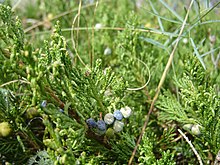| Juniperus horizontalis | |
|---|---|

| |
| Foliage and cones | |
| Conservation status | |
 Least Concern (IUCN 3.1) | |
 Secure (NatureServe) | |
| Scientific classification | |
| Kingdom: | Plantae |
| Clade: | Tracheophytes |
| Clade: | Gymnospermae |
| Division: | Pinophyta |
| Class: | Pinopsida |
| Order: | Cupressales |
| Family: | Cupressaceae |
| Genus: | Juniperus |
| Species: | J. horizontalis |
| Binomial name | |
| Juniperus horizontalis Moench 1794 | |

| |
| Natural range of Juniperus horizontalis | |
| Synonyms | |
Juniperus horizontalis, the creeping juniper or creeping cedar, is a low-growing shrubby juniper native to northern North America, throughout most of Canada from Yukon east to Newfoundland, and in some of the northern United States.
Description
Living up to both its scientific and common names, the species reaches only 10–30 centimetres (3+7⁄8–11+3⁄4 in) tall but often spreading several metres wide. The shoots are slender, 0.7–1.2 millimetres (1⁄32–1⁄16 in) diameter. The leaves are arranged in opposite decussate pairs, or occasionally in whorls of three; the adult leaf blades are scale-like, 1–2 mm long (to 8 mm on lead shoots) and 1–1.5 mm (1⁄32–1⁄16 in) broad, and derive from an adnate petiole. The juvenile leaves (on young seedlings only) are needle-like, 5–10 mm (3⁄16–3⁄8 in) long. The cones are berry-like, globose to bilobed, 5–7 mm (3⁄16–9⁄32 in) in diameter, dark blue with a pale blue-white waxy bloom, and contain two seeds (rarely one or three); they usually have a curved stem and are mature in about 18 months. The male cones are 2–4 mm (3⁄32–5⁄32 in) long, and shed their pollen in early spring. It is dioecious, producing cones of only one sex on each plant.
It is closely related to Juniperus virginiana, and often hybridizes with it where their ranges meet in southern Canada. Hybrids with Juniperus scopulorum also occur.
Distribution and habitat
The species is native to northern North America, throughout most of Canada from Yukon east to Newfoundland, and in the United States in Alaska, and continentally from Montana east to Maine, reaching its furthest south in Wyoming and northern Illinois. Amongst the sites it occupies are rocky areas of the east slopes of the Rocky Mountains.
Cultivation and uses
Well over 100 different cultivars have been selected for use as ornamental plants in gardens, their strictly prostrate growth habit being valued for ground cover. Popular examples include 'Bar Harbor', 'Blue Acres', 'Emerald Spreader', 'Green Acres', and 'Wiltonii' ("Blue Rug Juniper"). Many of the most popular cultivars have strikingly glaucous foliage, while others are bright green, yellowish or variegated.
Gallery
-
 Plant at Pancake Bay sand dunes, Ontario, Canada
Plant at Pancake Bay sand dunes, Ontario, Canada
-
 Juniperus horizontalis 'Wiltonii' as a garden plant
Juniperus horizontalis 'Wiltonii' as a garden plant
References
- Farjon, A. (2013). "Juniperus horizontalis". IUCN Red List of Threatened Species. 2013: e.T42237A2965318. doi:10.2305/IUCN.UK.2013-1.RLTS.T42237A2965318.en. Retrieved 13 November 2021.
- NatureServe (2024). "Juniperus horizontalis". Arlington, Virginia. Retrieved 18 August 2024.
- Juniperus horizontalis The Plant List (2010). Version 1. Published on the Internet; http://www.theplantlist.org/ 22 Nov. 2011
- Bailey, L.H.; Bailey, E.Z.; the staff of the Liberty Hyde Bailey Hortorium. 1976. Hortus third: A concise dictionary of plants cultivated in the United States and Canada. Macmillan, New York.
- Arno, Stephen F.; Hammerly, Ramona P. (2020) . Northwest Trees: Identifying & Understanding the Region's Native Trees (field guide ed.). Seattle: Mountaineers Books. p. 174. ISBN 978-1-68051-329-5. OCLC 1141235469.
Further reading
- Adams, R. P. (2004). Junipers of the World: The genus Juniperus. Trafford Publishing ISBN 1-4120-4250-X
External links
- USDA Plants Profile for Juniperus horizontalis (creeping juniper)
- Gymnosperm Database: Juniperus horizontalis Archived 2006-04-30 at the Wayback Machine
- Flora of North America: Juniperus horizontalis
- Plantmaps.com: Interactive Distribution Map of Juniperus horizontalis Archived 2017-03-19 at the Wayback Machine
- Lady Bird Johnson Wildflower Center, NPIN Database: Juniperus horizontalis (Creeping juniper, Creeping savin)
| Taxon identifiers | |
|---|---|
| Juniperus horizontalis |
|
- IUCN Red List least concern species
- NatureServe secure species
- Juniperus
- Flora of Western Canada
- Flora of Alaska
- Flora of Colorado
- Flora of Labrador
- Flora of Illinois
- Flora of Iowa
- Flora of Massachusetts
- Flora of Michigan
- Flora of Minnesota
- Flora of Montana
- Flora of New York (state)
- Flora of Newfoundland
- Flora of North Dakota
- Flora of Nova Scotia
- Flora of Nunavut
- Flora of Ontario
- Flora of Quebec
- Flora of South Dakota
- Flora of the Northwest Territories
- Flora of Vermont
- Flora of Wisconsin
- Flora of Wyoming
- Flora of Yukon
- Plants described in 1794
- Taxa named by Conrad Moench